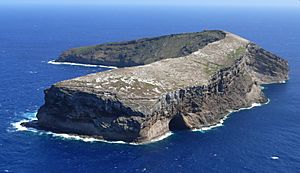Kaʻula facts for kids
Kaʻula Island, also known as Kaʻula Rock, is a small island shaped like a crescent moon. It is located off the coast of the Hawaiian Islands.
Mythology
In an old Hawaiian story about Papa and Wākea, Kaʻula is said to be their seventh child.
Geography

Kaʻula Island is about 23 miles (37 km) west-southwest of Kawaihoa Point on Niʻihau. It is also about 150 nautical miles (278 km) west of Honolulu.
The island is actually the top of a volcanic cone called a tuff cone. This cone sits on top of a much bigger, underwater volcano known as a shield volcano. The highest part of Kaʻula Island is about 548 feet (167 meters) tall.
Over time, the ocean has carved tall cliffs into the sides of the island. There is also a big cave on the northwest side. It is called Kahalauaola, which means Shark Cave. The island is slowly getting smaller because of erosion from the ocean.
Captain James Cook was one of the first Europeans to see Kaʻula Island in 1778. He called it "Tahoora."
Lighthouse
A lighthouse was built on Kaʻula Island in 1932. It was built by the United States Lighthouse Service. The lighthouse helped guide ships until it stopped working in 1947.
Military Use
The United States Navy has used Kaʻula Island as a practice area for bombing since at least 1952. Today, they use practice bombs that do not explode. However, in the past, real explosive bombs were used. Because of this, there might be unexploded bombs on the island.
You need special permission from the U.S. Navy to land on Kaʻula Island. In 1978, the state of Hawaiʻi said it owned Kaʻula. It also made the island a special place for seabirds, called a State Seabird Sanctuary. The Navy still uses the southeast part of the island for target practice.
Diving and Fishing
Even though no one lives on Kaʻula Island, people often visit it. Fishermen and scuba divers enjoy coming to the island. There is a famous dive spot called Five Fathom Pinnacle. It is about 3 miles (4.8 km) west-northwest of Kaʻula Island.
 In Spanish: Kaula para niños
In Spanish: Kaula para niños


